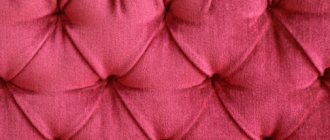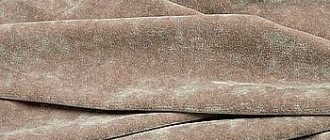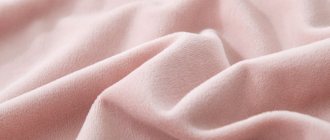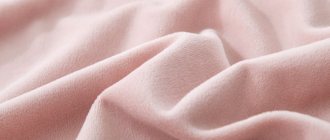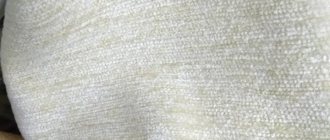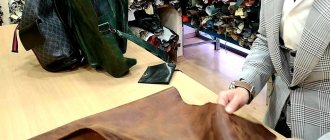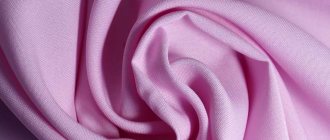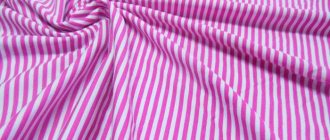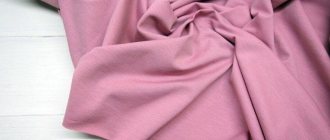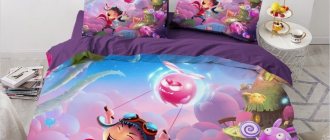What kind of material is velor
Velor is the name of not just one type of fabric, but a whole group of materials. The feature that unites them is the presence of pile, the length of which is slightly longer than that of velvet.
The material has a matte surface. Due to the special texture of velor, glare is formed when worn. Because of this, even uniformly colored fabric shimmers in different shades, creating an unusual effect.
Velor is a dense and durable material. But it does not tear or come apart along the seam under physical impact. If the material is purposefully pulled in different directions, it becomes deformed.
To the touch, the velor on the front side is fluffy and soft, and on the back side it is smooth with a slight relief. Thanks to the special weaving, even synthetic material is breathable. The fabric does not wrinkle.
The fabric is quite elastic and stretches well. Fits beautifully to the figure, hugging its contours. Due to the ability to form glare and a fairly large thickness, it can fill up. Characteristics may vary depending on the type of velor.
For the first time, velor began to be produced in the East as a replacement for expensive velvet. At the same time, velor fabric was expensive and was available only to the aristocracy. The material received its modern name in France. Velor is translated from French as “velvet”.
Corduroy looks and feels similar to velor. However, the first option has protruding stripes on the front side.
Typically, one of two technologies is used to make velor:
- Single panel technique. A rod is inserted under the threads from which the pile will be formed. The fabric is woven together with it. The rod is removed from the fixed loops. Next there are two options. In the first case, the loops are not cut, resulting in looped velor. In the second case, the loops are cut, then split velor is obtained.
- Double-panel. When weaving, two main threads are used at once. Two fabrics are woven from weft threads, connected to each other by a zigzag pile thread. The pile layer is evenly cut with special knives on machines. To weave the material using the two-sheet technique, 5 threads are used.
In addition to velor fabrics, you can find velor thread (sisal, bobbin velor) in sewing stores. During its manufacture, fibers are attached to the central single-twist thread.
Velor knitwear has a different weaving technology. The plush technique is used, which involves weaving loops with broaching.
Initially, fabric was made only from natural materials: wool, silk, cotton, leather. Nowadays synthetic and semi-synthetic materials are more common. Polyester and viscose are used for weaving fabrics. To increase elasticity and wear resistance, elastane and lycra are added.
The cost of velor depends on the composition. This figure varies between 150–3000 rubles per 1 sq. m. m.
Advantages of velor fabric
- does not stretch or shrink
- very durable
- wear-resistant
- retains heat well, very convenient and comfortable
- hypoallergenic
- excellent aesthetic characteristics will satisfy the needs of the most demanding consumers
- quite easy to care for
Types of velor
The concept of “velor” unites a whole group of fabrics with a fleecy surface. First of all, materials are classified by composition:
- Cotton. Natural fabric woven from long or short cotton fibers. To achieve a stretch effect, elastane, spandex, and lycra threads are added to the fabric. Knitted velor is woven from cotton. Natural material is characterized by high density, softness, hygiene and high aeration.
- Woolen. Uncombed fluffy wool fibers are used to make it. Sometimes artificial threads are added to the composition. The fabric is thick and warm. The material is used to make blankets, outerwear, and hats.
- Drapey. Merino wool is used to produce drape velor. Weaving is done using satin technique. The fabric is thin, light, durable and warm. This is a luxury option.
- Leather (natural) and split leather. Made from leather, the outer side of which has defects. In this case, the front side becomes a fleecy surface. Used for sewing footwear and bags. Natural velor is often confused with suede material, but the second option is less delicate and has a shorter pile.
- Artificial (synthetic). Made from polyester or viscose with the addition of lycra and elastane.
- Fur. Obtained using special grinding, which increases the thermal insulation properties of the material. In essence, it is leather velor, which has retained the fur layer on one side.
- Micro velor fabric. Thin synthetic material with short pile. It is characterized by increased wear resistance and hygroscopicity. It is used as lining fabric, as well as for sewing insoles. Microvelor "Enigma" has many color options.
The fabric is divided into types according to the method of weaving the fabrics. The following options are available:
- Knitted velor. For production, knitting technique with broaching is used. It is characterized by high elasticity, the ability to stretch in different directions, and wear resistance.
- Material with twill or satin weave. When using this technology, expensive royal fabric is obtained. The front side of the material acquires a light satin glow.
- Moire. The main feature of the fabric is that on the front side, piles of different lengths form patterns that become noticeable when the lighting changes.
- Jacquard velor. Jacquard weaving is used, which uses both the same type of threads and lurex with silk. Such canvases are distinguished by the presence of large and small patterns formed from areas with different textures. Used for furniture and cars.
To view the fabric review:
Velor is classified according to its purpose. The following types of material are distinguished:
- For sewing clothes. For these purposes, natural, wool, cotton, synthetic, and drape velor are used. These are thin, but dense and durable materials.
- Furniture. Consists of a durable base and soft bristles. Anti-vandal velor anti-claw is especially popular. It does not fray, does not wear out and does not lose its aesthetic appearance over time, and is not afraid of moisture. It does not show scratches from animal claws. Furniture materials also include flock and matting. Seamless self-adhesive velor is available for sale and can be used to decorate furniture yourself. Among the furniture materials, the most famous are Astra, Virginia and Silkshine fabrics.
- Automotive. This is a durable, wear-resistant material for interior trim. It is often used in Japanese-made cars. Caprovelur is also used for cars, which, thanks to the foam and mesh base, is characterized by increased wear resistance.
- Curtain. Used for sewing curtains.
The last parameter by which the material is divided into varieties is its appearance and processing method:
- Smooth. It has a pile of the same length over the entire area of the canvas.
- Smoothly colored. The finished fabric or threads are painted in one color. The most popular: black, blue, pink, green, red, brown, gray, beige. Plain-dyed fabric looks interesting because it shimmers in different shades depending on the lighting.
- Shaped. The pile is smoothed in places, which gives the material a heterogeneous appearance.
- Embossed. It has patterns formed from smoothed pile.
- Printed. The color design is printed over the entire surface.
See what furniture fabric looks like:
How to care for velor shoes
Manufacturers offer to purchase special protective agents along with a pair of shoes, which are applied immediately after purchase and left until the composition is completely absorbed. It is recommended to repeat the procedure at least three times, which will create reliable protection against moisture penetration.
A mixture of wax and fat is known from folk remedies, which is used to treat seams and the outer surface.
Snow, dust and dirt must be shaken off immediately upon entering the room with a special brush, preventing their penetration into the product. For cleaning, you can use a soft cloth, shoe brushes with natural bristles and an ordinary eraser. The sole should be washed so as to prevent water from getting on the velor fabric. Otherwise, unsightly stains will quickly form on it, which spoil its appearance and reduce its service life.
A spray foam cleaner that can be applied to stains and removed after it has completely dried will help deal with stubborn stains. It is recommended to dry wet shoes using special shoe dryers or newspapers, which should be changed regularly. It is not advisable to place boots close to heat sources to avoid deformation or damage.
In winter, salt stains often form on the surface of the material, which can be quickly removed using a piece of cloth moistened with a solution of water and soap or washing powder. Don’t forget about waterproofing agents that are applied after each shoe cleaning.
Advantages and disadvantages of the material
Velor is popular due to a number of advantages. They are presented in the list:
- Strength, durability. The fabric is resistant to physical impact, wear, and stretching. Some species are not afraid even of animal claws. They do not wear out, do not stretch, do not shrink, and do not lose their attractive appearance over time.
- Pleasant tactile sensations. The softness of the fabric makes it comfortable to wear and use.
- Low thermal conductivity. The material protects from the cold.
- Color fastness. The fibers hold the dye well. The material does not fade or fade. The color remains vibrant even after several washes. There is a special paint for velor.
- Beauty. The fabric looks expensive and noble; highlights and halftones are formed on it. The material hugs the body beautifully.
- Easy to care for. The fabric does not wrinkle and does not need to be ironed. Contaminants are easily washed off from things.
Matter has disadvantages that need to be taken into account when purchasing products:
- If not properly cared for, the material quickly loses its attractive appearance. During its operation, it is important to follow the basic rules.
- Quickly absorbs water along with dirt. Gets dirty easily.
- When washed, it loses some of the lint. Areas appear in which the pile is directed in different directions. The matter begins to look sloppy.
Watch the video:
Properties, strengths and weaknesses of the material
Aesthetic appearance is not the only advantage of velor leather.
Its positive properties also include:
- relatively low cost;
- similar in appearance to suede;
- softness;
- elasticity;
- naturalness;
- good thermal insulation properties;
- durability of operation under suitable weather conditions and proper care.
It is worth considering the disadvantages of the material:
- poor moisture tolerance;
- high ability to absorb water, dirt, chemicals;
- rapid abrasion of the fleecy surface;
- low breathability;
- ability to attract dust, hair, small debris.
Obviously, the pros and cons balance each other and you should start, first of all, from your ability to properly care for the thing and use it.
How does velor differ from other materials?
Velor is often confused with other materials. It is important to know the main differences:
- Suede leather. If velor has a pile located on one side, then suede has a pile on both sides. Also, there are no fingerprints left on the suede; its color is uneven.
- Velvet. It has a shorter pile, is made from natural silk, feels rougher than velor, and is more expensive.
- Microfiber. It is a full-fledged analogue of velor, but unlike the latter, during its manufacture the pile is not woven into the base, but glued to it. Microfiber is thinner and less wear-resistant.
- Chenille. Soft and warm material that does not absorb foreign odors and does not wrinkle. It is characterized by low wear resistance and fragility. It fades quickly and loses its attractive appearance.
- Polyester. Has shorter pile. Poor air permeability and rougher to the touch than velor fabric. It is characterized by durability and low price.
- Velveteen. The main difference is the scars on the front side. The material does not wrinkle, is comfortable to wear, durable. It fades, shrinks, and loses its attractive appearance with frequent washing.
- Flock. Over time it wears out and absorbs odors. It is durable, easy to maintain, and low hygroscopicity.
Velor composition
- Velor fabrics can be made from various materials: with the addition of cotton, as well as wool or mixed fibers.
- At the same time, there is drape velor; in order to produce it, Merino sheep wool is needed.
- With the addition of various artificial threads, synthetic velor is obtained; natural and leather velor is also found on the textile market.
- Density 240 g/sq.m.
Areas of application of fabric
Velor fabric and velor coating have found application in many areas:
- In the interior. Velor is used for furniture upholstery; bedspreads, curtains, decorative pillows, and cushions are made from it.
- For clothes. The fabric is used to make adult and children's clothing: dresses, sundresses, leggings, blouses, jackets, etc.
- Shoes and bags. The material is used in the production of shoes and bags.
- For car upholstery.
To view the photo gallery:
Properties of velor
- A distinctive feature is the thick velvety pile, soft and pleasant to the touch.
- For furniture upholstery, high-density material is used, the basis of which is polyester. Cotton, rayon, spandex, polyamide and other man-made fibers are sometimes added. And the more synthetics in the composition, the stronger and more durable the upholstery.
- Density varies from 240 to 375 g/m². This figure indicates the weight of the threads in grams per square meter of material. The denser the fabric, the greater the value. For comparison: the average density is 200 g/m².
- Abrasion resistance according to the Martindale test from 20,000 to 40,000 cycles. Manufacturers are required to indicate this parameter. Since people constantly sit on the sofa, they test the fabric by friction. A special apparatus calculates how many cycles the material will withstand. Acceptable numbers start from 20 thousand.
Velor care
In order for velor to last a long time, it is important to properly care for it. If the rules are violated, the fabric quickly becomes unusable.
How to wash and dry velor items:
- Can be washed by hand or in a washing machine. The water temperature should not be higher than 30 degrees.
- Detergents should be delicate. It is better to use liquid forms.
- Stains are removed locally by applying stain removers to them.
- It is not recommended to intensively rub or twist the material. It is shaken and allowed to drain randomly.
- To avoid crushing the pile, do not use clothespins when drying.
- Woolen and leather velor products are cleaned with a dry soft brush.
- The fabric cannot be ironed.
The topic will be complemented by a video:
How to wear velor shoes
The high quality of the material ensures a long service life with proper care and careful handling of shoes or boots. You can refresh the appearance and straighten out the wrinkled pile using a water bath, holding the shoes over the steam for several minutes and gently wiping them with a piece of cloth or a brush. To preserve color, it is recommended to use special creams or coloring compositions for velor in aerosol cans.
The beauty of velor products can delight their owners for many years if they are provided with timely and proper care. They will emphasize the attractiveness and elegance of the suit, giving confidence and impeccability to the entire appearance.
Velor - furniture fabric
For many years, upholstered furniture covered with velor has been popular and in demand. Even among the many different upholstery materials, consumers most often give preference to it.
Furniture velor differs from that used to make clothing. First of all, density, strength and cost.
The fabric has a velvety texture and is easily laid out in the desired shape, making it suitable for upholstering furniture even of complex shapes. Velor made from natural fibers such as cotton, wool and even silk, as well as from synthetic threads.
To achieve better results, they are usually combined. Among the main advantages of the finished fabric are high wear resistance, aesthetics and hypoallergenicity.
It retains heat well, creates special coziness and comfort. The material is also very pleasant to the touch, which plays a significant role when choosing upholstery.
Velor costs an order of magnitude more than similar fabrics, but thanks to its qualities, such a purchase pays for itself very quickly.
- Smooth - the pile is laid vertically, which is why the structure of the fabric is uniform;
- Shaped - on the contrary, non-uniform, the pile is located at an angle, can be of different lengths and plays with shades;
- Printed - with a printed pattern;
- Embossed - also with a pattern, but in this case it is achieved by laying the pile, which gives furniture velor an even more luxurious look;
- Smooth-haired is its most expensive variety.
- In addition, there is auto velor for upholstering seats and car interiors and jacquard, which is used to stretch mattresses and sofa cushions.
It will be difficult for an inexperienced consumer to distinguish furniture velor from velvet, corduroy, microsuede and microfiber, but differences between them still exist. Corduroy and velvet are relatively thin fabrics, so they are widely used in light industry, namely for tailoring.
Microvelor is almost smooth and has a porous coating, which allows the fabric to breathe. Microfiber consists of nylon fibers.
Particularly popular are microfiber underwear, sportswear, since the material is treated with silver ions, and napkins, which are simply irreplaceable for cleaning - they do not leave streaks on glass surfaces and absorb liquids very well. The listed fabrics are similar in appearance and have a velvety pile.
Among them, furniture velor is the densest and heaviest. When purchasing, you should pay attention to the quality of the surface.
Regardless of the type of material, it should be uniform and without bald spots. In the light, good velor will softly play with tints.
Velor upholstery is elastic and can withstand even heavy loads, wears out slowly, which is why, with proper care, it will last the owners for a single year, it is resistant to fading, especially if synthetic fibers predominate in the composition, it is antistatic and collects much less dust than other pile fabrics. Despite all the advantages, velor furniture is still sensitive to greasy stains, dirt and pet hair. If there are animals in the house, you need to take special care of the coating.
Velor for furniture photo
In the catalog of furniture fabrics, velor is presented in several versions:
- Smooth. A surface with a uniform structure and vertical pile arrangement.
- Shaped. The surface is uneven, some parts may be smooth.
- Printed. A color pattern is formed. As an alternative, you can use an embossed structure, where the design is created by laying the pile in different directions.
- Smoothly colored. The monochromatic structure makes the furniture look more expensive.
